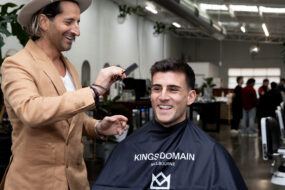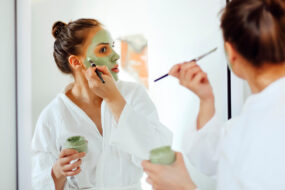The benefits of gua sha (and why it might be better than a facial)
Gua sha is used in Traditional Chinese Medicine to promote healing and wellness. But what exactly is it and does it actually work? Here’s what you need to know.
Unless you’ve been living under rock, you’ve probably seen people on TikTok rubbing their faces with stones to help stimulate circulation, reduce puffiness and improve the appearance of their skin.
While it may look like tomfoolery, there’s actually a lot more to the popular practice known as gua sha – and it’s not just for the face.
So, what is gua sha?
A Traditional Chinese Medicine (TCM) healing practice, gua sha is used to move stagnant energy or qi in the body to promote wellness and alleviate pain.
Generally performed on the body, the method can also be used on the face, head and neck.
Loosely translated, “gua sha” means “scraping” and it literally involves rubbing or stroking the skin with a massage tool such as a coin, spoon or stone to help improve blood flow and stimulate the body’s natural healing abilities.
What are the benefits of gua sha?
Through skin scraping, gua sha promotes blood circulation, delivering oxygen and nutrients to cells throughout the body.
It may also support the immune system by reducing inflammation.
“It’s great for oncoming colds and flu because of the anti-inflammatory response it initiates,” TCM practitioner and Zhong Centre founder Abbie Cloherty says.
Gua sha helps release muscle tension by breaking up fascial adhesions, making it an excellent go-to for post-workout recovery, TCM practitioner and Nourished Temple founder Miriam Drescher explains.
“When you’re working on the deeper tissues of the back, you’re bringing cellular waste up to the surface,” Miriam explains.
According to TCM, because gua sha helps balance the flow of qi, Miriam says it can also contribute to mental clarity, emotional stability and overall wellbeing.
“I’ve had amazing results with anxiety or emotional imbalances using gua sha as a treatment,” Miriam says.
What is the best type of gua sha tool to use?
Gua sha tools are made of various materials, including porcelain, stone, metal, wood and crystal.
Usually flat and smooth, they come in different shapes and sizes, and Abbie says the right tool depends on the area of the body you’re focussing on.
Particular stones are often selected for a specific purpose.
For example, Abbie recommends jade as her choice of stone for facial gua sha as it’s softer.
“In TCM, we use jade because it is a healing mineral and is respected in traditional culture,” she says.
Is gua sha effective on the face?
While it was originally performed on the body, the practice has evolved to include the face.
Abbie says gua sha is an ideal therapy for the face as it stimulates lymphatic drainage, relieves puffiness and promotes healthy skin.
The improved circulation supports the skin’s natural healing processes, reducing the appearance of fine lines and wrinkles.
Facial gua sha also incorporates the stimulation of pressure points that relieve other ailments too, Abbie says.
“The areas of stimulation within the face are correlated to other systems within the body.
“For example, facial gua sha stimulation of the nasolabial area increases antihistamine response for allergies – and this area also helps improve bowel function,” she says.
Abbie says facial gua sha may also assist with migraines, jaw clenching, back pain and period pain.
How to do a gua sha facial massage at home
Abbie, who runs the online Glow Sha course at Zhong Centre, offers the following tips to help you maximise the benefits of a DIY gua sha facial massage:
- Clean your face and apply a serum to smooth the skin surface.
- Hold your gua sha stone at a 35-degree angle and use short strokes, in one direction.
- Scrape down the neck, and up and out on the face.
- Do nine to 10 strokes down the neck, then go under the chin.
- On the face, start next to the nose, doing invigorating circles, then sweep over the ear, followed by the different areas of the face.
- Remember to go into the hairline.
- Be mindful of redistributing filler and if you’ve just had Botox, give the area a fortnight’s rest.
- Avoid any areas that have acne or broken skin.
More on natural therapies:
- What to know about acupuncture
- Why lymphatic massage is the latest A-list wellness therapy
- Can the power of crystals revitalise your wellbeing?
- How reflexology can help you restore balance
Written by Aimee Curatolo.



